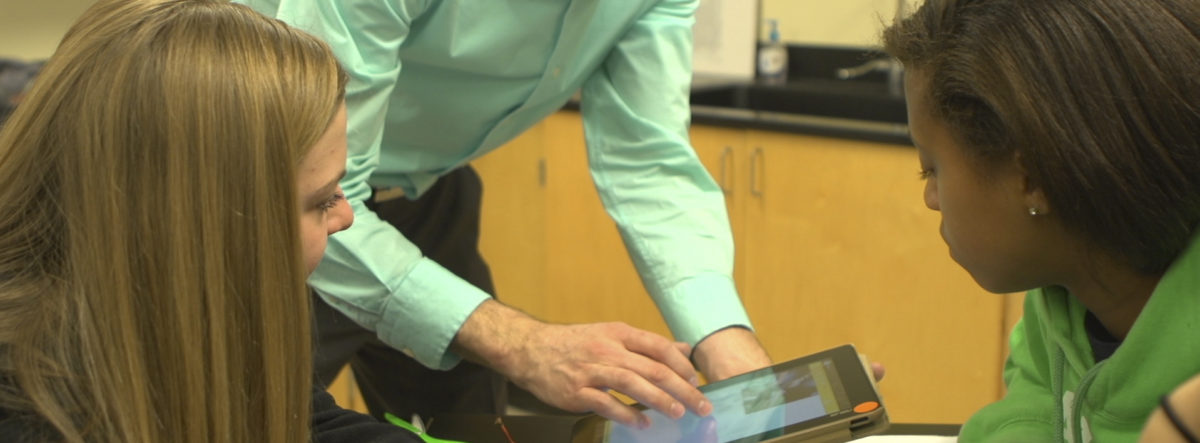
This post originally appeared in Amplify’s Viewpoints series.
In his new book, “Digital Leadership: Changing Paradigms for Changing Times,” Eric Scheninger outlines what education leaders must do to be successful in the digital age. Amplify talked with Sheninger about his personal transformation, the dramatic changes at New Milford High School in Bergen County, New Jersey and his new book about his journey.
Tell me a little about your transformation from an old-school principal to an educator for the digital age. How did it happen?
One day changed everything. In 2009, I tried Twitter for the first time. That little experiment was the catalyst for everything we’ve accomplished at NMHS. I was lurking and learning, and I became educated on the error of my ways.
My book is my journey that I’ve taken, as a principal who was not interested in social media, did not use social media, who created a school environment that was the opposite of the real world, to now, working beside our staff to allow our students to use real-world tools to do real-world work. It’s about the essential practices and behaviors that leaders must adopt to be successful and how digital tools can be seamlessly integrated to help us do what we do better.
So, what specific changes did you implement at NMHS?
There are seven pillars I write about in my book, and we’ve implemented all of them at NMHS.
Communication: We’re meeting our stakeholders where they are, using free social media tools to get out information that’s timely and applicable.
Public relations: As we’ve changed, we’ve been transparent. Digital leadership is about becoming a storyteller-in-chief. With free tools, we’ve created a foundation of positive public relations. It’s not that we weren’t always doing good work, but now we have the tools and the strategy to get our message out.
Establishing a positive brand presence: We’ve created a brand that has resonated. Everyone is hearing our name, our colors, our mascot—and what’s coming to mind is innovation, student engagement, increasing achievement.
Professional growth: Innovation doesn’t happen in a vacuum. I’ve worked with my teachers in growing their personal learning networks (PLNs). Through social media, I have world-renowned experts and practitioners constantly feeding me the best ideas in the world. It’s through personal learning networks that we’ve learned about the flipped instructional model, bring-your-own-device (BYOD), and the integration of social media tools in the classroom.
Student engagement and learning: We’re having students demonstrate conceptual mastery by creating artifacts of learning, allowing them to make choices about which technology tools they want to use to demonstrate their understanding.
Re-envisioning learning environments and spaces: We’ve created learning environments that are reminiscent of the world in which we’re preparing our students to be successful. We’ve implemented bring-your-own-device. Students are using their own devices as essential learning tools. Because we’re teaching them how to use their tools for learning, we’re also teaching them about digital citizenship and responsibility. As a result, we’ve seen a significant drop in inappropriate behavior both online and in-person.
Opportunity: Finally, telling our story has brought opportunity for our school—companies giving us free technology, professional development, etc. Recently we created a Makerspace where students hack and invent. We learned all of this by being connected.
My book is about creating a system that students want to be a part of, that’s going to provide essential skill sets that society demands—communication, collaboration, critical thinking, problem-solving, technological proficiency, digital literacy and entrepreneurship.
How has the culture of NMHS changed as a result of integrating technology in meaningful ways?
Anyone would say, when you walk into NMHS today, the culture is so different than it was prior to 2009. Kids want to be at our school. Our attendance is up, and we werenationally recognized by Newsweek as one of the 2,000 best high schools in the country this past year.
One day recently, I walked into an English class, and every kid shared his or her presentation with me via Google Drive. They weren’t afraid to share their work with their principal. That’s huge. I couldn’t be more proud. Our school is in a better position than it was four years ago, and we’re continuing to improve upon our successes.
How do you motivate teachers to integrate technology in their classrooms?
We don’t have any technology mandates. We give our teachers the autonomy to take risks, to not fear failure, and we empower them to chart their own path to provide a better learning experience. Teachers are willingly embracing technology and learning together. That’s what digital leadership is all about.
What’s one thing you hope readers will take away from your book?
Change can and does happen. You can integrate technology and create more rich, authentic learning environments in ways that aren’t going to drain your budget. My book debunks many of the myths around technology integration in schools—cost, safety, legal issues, etc. Technology can have a natural pedagogical fit that allows us to transform teaching and learning to make it more relevant, applicable and meaningful. When you make a culture guided by those principles, you set the stage for increases in engagement, learning and achievement. I want people to take away the vast possibilities that are out there for every school.
Over the past few years, Eric Sheninger has become a role model for principals who want to integrate technology into their schools in meaningful, transformative ways. He’s won numerous awards for his leadership, including the Digital Principal Award from the National Association of Secondary School Principals; his blog, “A Principal’s Reflections,” was twice named Best School Administrator Blog by Edublogs; he frequently travels around the country to speak at conferences; and he has more than 55,000 Twitter followers.